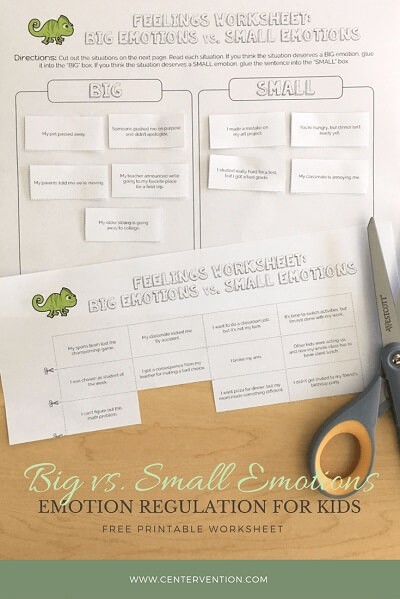Understanding how to regulate emotions isn’t something we are born with, it is a skill we learn over time. One of the first components of that skill is evaluating everyday situations to determine if the they are worthy of an emotional response.
For younger students, many times they overreact at what we would consider a minor setback. If you’re an educator, you see examples of this every day. It’s not their turn to be line leader, so they pout for two hours, or they make a small mistake on an assignment and rip their paper up.
Using these feelings worksheets, you will help your students differentiate between situations that truly deserve a big emotion and those that really only deserve a small reaction.

Recommended Grade Level: Elementary
SEL Skill(s): Emotion Regulation
Duration: 30 minutes
Materials:
- Feelings Worksheet for Grades 2 – 5
- Optional: Feelings Worksheet for K – 1
Feelings Worksheets Instructions for Grades 2 – 5
The first page of the worksheet is divided into two halves: BIG and SMALL. Students will cut out the situations on page two, decide if it deserves a big emotion or a small emotion, and glue (or tape) it into the appropriate section representing BIG EMOTIONS or SMALL EMOTIONS.
On page two of the feelings worksheets, students will find a grid of situations that might evoke big emotions or small emotions. Examples include:
- I want to do a classroom job, but it’s not my turn.
- My parents told me we’re moving.
- Someone pushed me on purpose and didn’t apologize.
- I didn’t get invited to my friend’s birthday party.
- My teacher announced we’re going to my favorite place for a field trip
- My pet passed away.
Note: If you are working with younger students, you may want to use the K – 1 worksheet. It is focused on helping students with the basics of identifying feelings.
Additional Resources
Books
- The Lonely Little Emoji by Harry Harmon
- Wilma Jean – The Worry Machine by Julia Cook
- H is for Happy by Evan Nimke (for K-1 students)
- Me and My Feelings by Vanessa Green Allen
Related Lessons and Programs